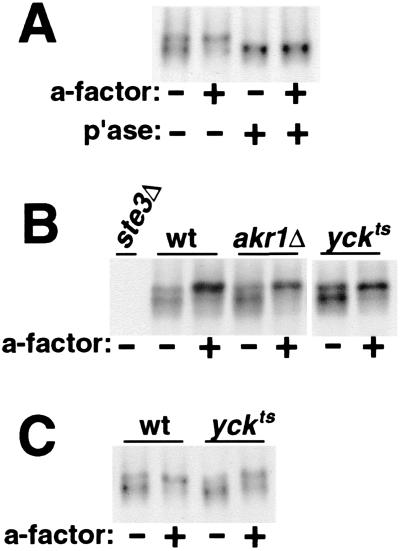FIG. 3.
Effects of akr1 and yck mutations on Ste3p phosphorylation. The constitutive and a-factor-induced phosphorylation of Ste3p was monitored by assessing the effects of a-factor treatment on the gel mobility of newly synthesized Ste3p. MATα cells were pulse-labeled for 10 min with [35S]methionine-cysteine, chased for 10 min with excess cold amino acids, and then treated for an additional 15 min with a-factor or mock treated in parallel. This protocol allows the labeled Ste3p to be maximally available at the cell surface for binding the a-factor ligand. Protein extracts were prepared from the cells, and the Ste3p purified by immune precipitation was subjected to SDS-PAGE and autoradiography. (A) Constitutive and ligand-induced phosphorylation of Ste3p. Extracts from wild-type MATα cells (NDY414), treated with or without a-factor pheromone, were either digested with potato acid phosphatase (p'ase) or mock digested (no phosphatase added). The NDY414 strain used for this experiment has Ste3p expressed from the HIS3 promoter instead of from its natural promoter. The level of Ste3p expression from the HIS3 promoter is increased two- to threefold relative to the basal-level expression from its natural promoter. The increased expression results in no obvious alteration to the profile of phosphorylated species apparent by this pulse-chase analysis (compare with panels B and C; Ste3p for these panels is expressed from its natural endogenous promoter). (B) Effects of the akr1 and yck mutations on Ste3p phosphorylation for cells growing at 30°C. Wild-type (wt) MATα cells (LRB759) as well as isogenic akr1Δ (NDY1037) and yck1Δ yck2ts (LRB757) cells were cultured at 30°C and then labeled and treated with a-factor as described above. (C) Effects of the yck mutations on Ste3p phosphorylation for cells growing at 37°C. Wild-type (LRB759) and yck1Δ yck2ts mutant (LRB757) cells cultured at 25°C were shifted to 37°C 10 min prior to the start of pulse-labeling.

